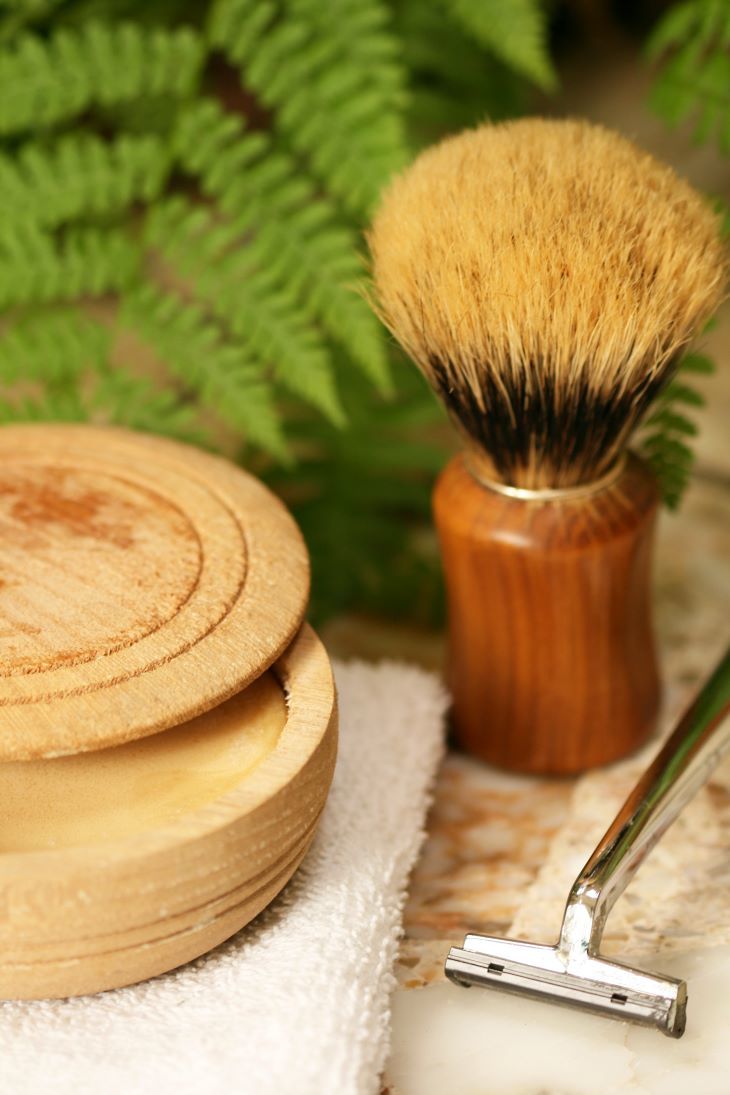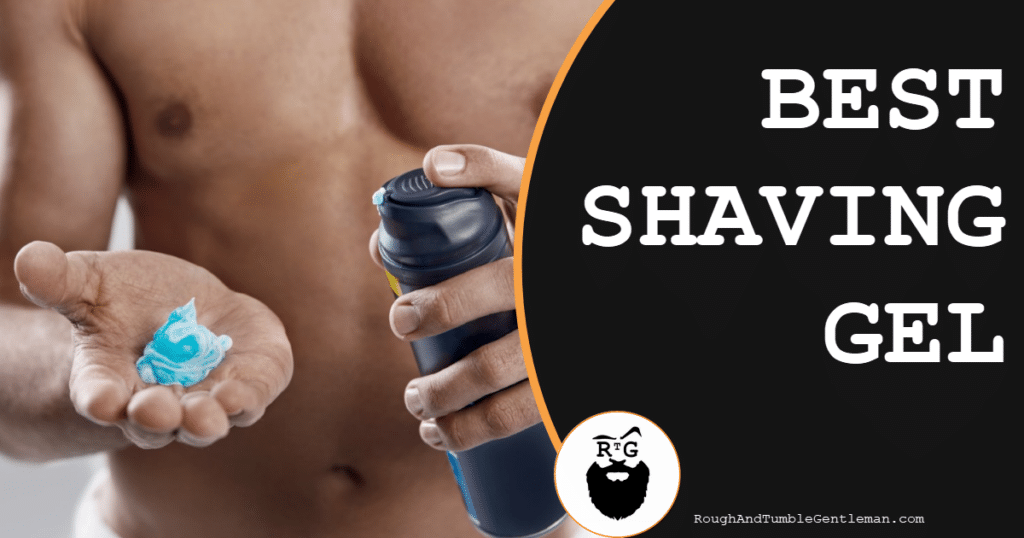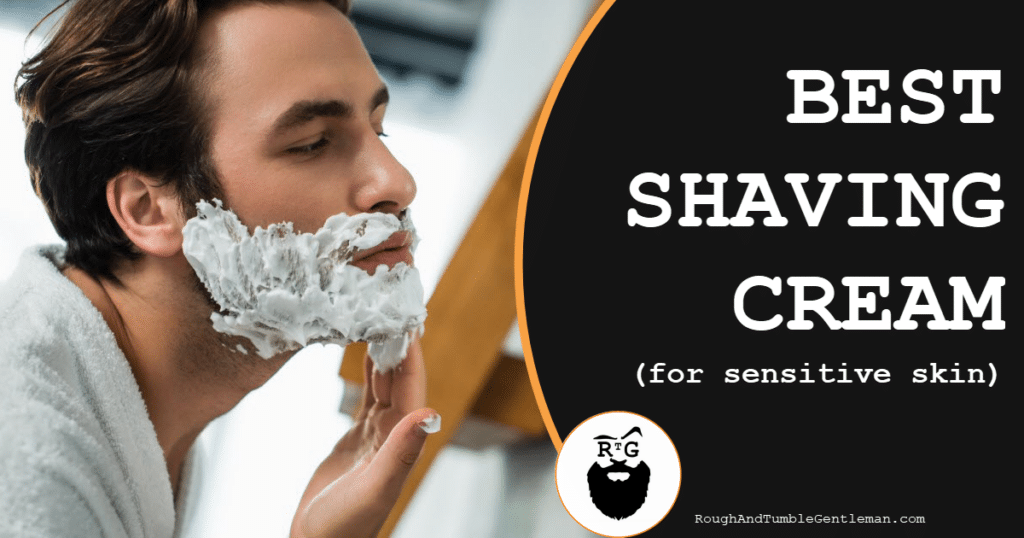
If you’re on a budget or trying to avoid synthetic chemicals in your grooming routine, learning how to make your own DIY shaving cream can be extremely rewarding. Here we’ll give you our three favorite shaving cream recipes—two for face and one for legs and body (but you can use them any way you please!).
Homemade shaving cream recipes can run the gamut from “quick and easy” to “complex chemistry projects,” but the recipes below will give you room to experiment, no matter how much time you have to spend (and how much patience you have for the project!).
You can follow these recipes exactly as they are, or you can try altering them based on some of the suggestions we make below. Who knows? Maybe you’ll create something so new, and so original, you’ll be able to start your own line of shaving creams. Dream big, youngster!
Alright, enough chit-chat. Here we go:

Our Three DIY Shaving Cream Recipes to Try
Here’s our keeping-it-simple, just-the-basics shaving cream recipe:
1: A Basic Shaving Cream for the Face
This is a great starting point for most shaving enthusiasts: it’s simple to follow, and you probably won’t run into trouble sourcing these ingredients.
The formula itself includes nourishing oils that will help you soften your beard and the skin below it, as well as castile soap, which will help the oils rinse away more easily from both your skin and your razor blade.
As you continue your DIY journey, you’ll be able to adapt this recipe based on your personal preferences. Just be aware that, unlike store-bought shaving cream, it’s not going to create as much of a lather. If you’re willing to go all-out in search of the perfect creamy lather, you might want to try our next recipe, instead.
Ingredients:
> 2 and 1/2 ounces of shea butter
> 2 ounces of jojoba oil
> 1 ounce of castile soap
> 10-15 drops of cedarwood essential oil
Instructions:
Step 1: Melt the oils. To start, melt your shea butter and jojoba oil in a double boiler, which is basically a pot-within-a-pot contraption. We like the Farberware Double Boiler (affiliate link), but if you’re not using a double-boiler, you can use a heatproof mixing bowl on top of a pot of simmering water. Shea butter is solid at room temperature, so this will allow you to easily combine the two. This shouldn’t take longer than a few minutes. Stir the oils together to make sure they’re well-combined.
Step 2: Let the oils cool. Once the oil and butter have melted together, take them off the heat and let them cool down a little bit—they don’t need to actually get cold, a warm temperature is just fine!
Step 3: Add the soap and scents. Now that your mixture is at a comfortable temperature, add the castile soap and cedarwood essential oil. Stir to combine everything well.
Step 4: Transfer and cool. At this point, you should have a semi-liquid mixture that smells like cedarwood. Transfer your mixture into a mixing bowl, and place it in the fridge for a few hours so it can cool down completely and reach a more solid texture.
Step 5: Mixing time! Once your shaving cream mixture is semi-solid, it’s time to whip it into shape. You can use a hand mixer, an immersion blender, or even a stand mixer. After 2-4 minutes of whipping, you should have a fluffy, well-aerated shaving cream ready to use. If you want to do it by hand, make sure you work the material very well.
2: A Homemade Shaving Cream That Lathers
If you’d like to dive deep into traditional DIY shaving creams, give this method a try. This shaving cream recipe lathers thanks to a soap-based formula, and it can work well both for the face and body.
This lathering soap-cream requires more effort, time, and care than our basic recipe, but you’re more likely to end up with a formula that’s similar to traditional shaving creams. Some of the ingredients, like stearic acid (a fatty acid that gives this shaving cream slip and a very rich lather), are less well known, although thankfully, they’re not too difficult to source.
This recipe creates what’s considered a “dual lye soap.” In soap making, lye is the alkaline ingredient that transforms regular oils into soaps. The lye used to make hard soaps is sodium hydroxide, while liquid soaps are made with potassium hydroxide. By using both, we can create a hybrid cream soap that is very suitable for wet shaving. This recipe leaves a lot of the oils “unsaponified,” though, which means that they’ll still have some naturally moisturizing effects.
Ingredients:
> 3 ounces coconut oil
> 2 ounces jojoba oil
> 2 ounces shea butter
> 1 ounce stearic acid
> 0.2 ounces sodium hydroxide
> 1.18 ounce potassium hydroxide
> 0.5 ounce glycerin
> 10 ounces distilled water
> 10-15 drops of cedarwood essential oil
Directions:
Step 1: Melt the oils. To start, melt the oils together. You can use a double boiler, or simply melt the oils down in a pot on low heat. Mix everything together so the oils can combine well. Once they’re melted, take them off the heat.
Step 2: Combine liquids and lye. Next, in a separate container, combine the water with the glycerin. Then, add the potassium hydroxide and sodium hydroxide (i.e. the lye) to the mixture, and give everything a good stir to combine. Make sure that the lye dissolves completely in the water.
Step 3: Combine the oils and lye. Now is the fun part! When the oil is still hot but not boiling (around 180-200 fahrenheit), pour it slowly into the lye and water mixture while gently mixing with a spatula. You may notice the stearic acid curdle a little from the lye, which is perfectly normal.
Step 4: Mix away. Once your mixture is combined, you can use an immersion blender to whip it together thoroughly (or, if you really want to put some effort into it, work it by hand). Take your time with this part, mixing for at least 5 minutes.
Step 5: Add the essential oil. After blending for a while, your soap mixture will start to thicken up. Before it gets too thick, add the cedarwood essential oil and then continue blending for 5 more minutes or until thick.
Step 6: Set it aside. After blending for a while, your mixture should have a thick texture reminiscent of pancake batter. At this point, cover it up or transfer it into a sealable container, and set it aside to rest for a week or two.
Step 7: Check on it. After enough time has passed, test your soap. You can use a pH strip to ensure the pH is between 8 to 9, or you can try a zap test.
To do a zap test, wet your finger with a bit of water, and lightly touch the soap. Then, touch your finger to your tongue, and if you feel a zap (a little like tasting a battery!) then your shaving cream isn’t ready yet. Leave it for a few more days, and try again!
3. An Easy Shaving Cream for the Legs and Body
This basic homemade shaving cream for the legs (or any other part of your body that needs shaving!) is quite similar to our recipe for the face.
The main difference is that it contains a nice, rich dose of coconut oil. Coconut oil is a soothing, moisturizing oil with a thicker texture than jojoba oil. It’s a lovely option for the body, but if your skin is quite dry, you can use it on the face as well.
Ingredients:
> 2 and 1/2 ounces of shea butter
> 2 and 1/2 ounces of coconut oil
> 1 ounce of castile soap
> 10-15 drops of lavender essential oil
Instructions:
Step 1: Melt and combine. Since coconut oil and shea butter are both somewhat solid at room temperature, you will need to melt them first to allow them to mix. A double boiler is ideal for melting them gently without overheating the mixture.
Step 2: Take them off the heat. Once the shea butter and coconut oil are completely melted, stir them to combine and take them off the heat.
Step 3: Add the rest of the ingredients. Once the mixture isn’t too hot anymore, add the castile soap and lavender essential oil. Stir the mixture to incorporate everything together.
Step 4: Cool until semi-solid. Now it’s time to let the mixture cool down completely, which will also allow it to harden somewhat—an hour or two in the fridge should be enough. If necessary, make sure to move the blend to a mixer-safe bowl beforehand.
Step 5: Whip it up. Once it’s cool, you’ll have a slightly solid balm, which isn’t ideal for shaving. To achieve that creamy texture, you’ll need to aerate the oil and soap blend with the help of a hand mixer, stand mixer, or immersion blender. Whip continuously for 2-4 minutes, and you’ll soon have a fluffy, homemade shaving cream.

How to Alter Your Recipe
We’ve provided some easy-to-follow, basic recipes, but you should feel free to change them a little. From the scent to oil composition, there’s a lot of room to get creative, so here are some ideas you can try. You can:
Change the Scent. We may love cedarwood for its masculine, woodsy scent, but that’s not true for everyone, so feel free to change the essential oil blend that you use in your shaving cream.
Different essential oils have different aromatherapeutic properties that can impact both the mood and the skin. For example, lavender is considered calming, tea tree oil is said to have antimicrobial properties, and peppermint is mildly cooling and refreshing.
Just keep in mind that essential oils (as well as synthetic fragrances) do have the potential to irritate the skin—especially if you use them undiluted. Don’t add too many drops to your recipe, and do a patch test on your wrist or neck first to ensure that you don’t have an allergy.
If you have very sensitive skin, you can create what’s called a “naked shaving cream.” This just means that it’s scent-free.
Change the Oils. Our recipes include carrier oils. Carrier oils are fluid, fatty oils that are usually derived from plant sources. In a shaving cream, carrier oils have a few different but very important jobs.
First of all, carrier oils add slip to the shaving cream, which helps the razor blade glide smoothly over the skin which is important for preventing irritation or cuts.
Beyond this, carrier oils also have a wide range of skin benefits! They’re emollients, which means that they fill in gaps between dead skin cells, which helps to soften and lubricate the skin, making it stronger and more moisturized in the long term.
Then, different carrier oils can have their own unique properties. Some are better at penetrating into the hair shaft, others are very soothing to the skin, and some have strong antioxidant effects that help prevent irritation and aging. If you make a soap-based recipe, some oils will saponify differently from others.
Quite a few of our recipes included coconut oil. It’s a deeply moisturizing oil that sinks into the hair, making the strands more pliant for an easier shave. In high quantities, coconut oil has the potential to aggravate acne-prone skin, but in small quantities, it may actually exert some antimicrobial effects.
Other recipes included jojoba oil. Jojoba oil is actually a wax ester, with a naturally long shelf-life. It’s neither too greasy nor too light, and it does a very nice job of enhancing slip, which is why we like it for the face. Some studies also suggest that it has anti-inflammatory effects, so it may help to soothe the skin or prevent irritation.
However, you can switch up the oils to achieve slightly different textures and enjoy different properties! Here are a few other oils you may like:
Grapeseed oil is very light with a slightly dry texture and is high in antioxidant resveratrol. You may like its texture if you have oily skin, but note that it has a short shelf-life.
Castor oil is a unique option that’s well-loved by many shaving DIYers. It has a dry feeling, like grape seed oil, but a thicker texture, which is quite unusual. Unlike other oils, it also naturally contains glycerin which helps to directly hydrate the skin.
Fractionated coconut oil (aka MCT oil) is another very stable option that many DIY experts love, with a surprisingly silky texture. It’s a good skin softener that feels amazing, but since it’s processed, it doesn’t have as many naturally soothing constituents.
This is just a fraction of the possible oils you can try in your DIY shaving cream! Don’t be afraid to experiment with small batches, to trial different oils, and discover which you like best.
Change the Butters. Plant butters also count as carrier oils, and in reality, they’re not too different from oils. The main difference between butter and oil is that the butter is more solid at room temperature. This is because plant butters tend to be higher in solid fatty acids like stearic acid and palmitic acid. If you skip the butter completely, you’ll end up with a shaving oil, instead.
Shea butter is our favorite because it’s creamy, not overly greasy, and quite accessible. However, if you want a shaving cream with a slightly more dry, silky feel, you might prefer to use mango butter. Cocoa butter also presents an attractive option, primarily because of its delicious chocolate scent.
Finally, there’s the option of tallow, which is actually a rendered beef fat. It’s animal-derived, which some readers may want to avoid, but many die-hard wet shavers swear by it for its incredible conditioning properties.
Add Hydrating Ingredients. Oils and plant butters help seal moisture into the skin, but if you also want your shaving soap to directly increase the water content in your skin or hair, add a hydrating agent. Ingredients like honey, glycerin, aloe vera, and proteins like oat, silk, soy, and milk protein do this quite well.
Just be aware that once you add an ingredient like this to your formula, you increase the chances that it’ll spoil more quickly. A soap-based formula like our lathering shaving cream and handle it, but if you do this with our more basic recipes, stick to small batches and keep them in the fridge when you’re not using them.
Try Other Add-Ons. We’ve covered the main ingredient categories that’ll allow you to change up your recipe, but here are a few more potential add-ons.
Clay or baking soda are popular for taking away some of the oily texture from homemade shaving cream. Bentonite clay or kaolin clay can be added to both soap-based recipes as well as more basic DIYs.
Baking soda isn’t a good addition to a lathering recipe, because the soap-based cream is already quite alkaline. However, it can be a fine addition to a very greasy DIY cream, especially if you’re leaving out the castile soap.
Vitamin E is a fantastic add-on that’s absolutely worth considering if you want to make larger batches of shaving cream or if you want to experiment with carrier oils that go bad more quickly. As an antioxidant, it’s great for the skin, but it also helps stabilize carrier oils with shorter shelf-lives like grapeseed or hemp oil.

How to Store Your Homemade Shaving Cream
We told you how to make your own shaving cream, but we left out the storage. That’s because storing your shaving cream is up to you—a simple mason jar works well, but any sealable glass or stainless-steel container will do.
If you don’t use essential oils in your formula, plastic can also work. What’s key is that you store your shaving cream in a clean, dry place. With the non-soap recipes, be careful not to introduce any water into your container when you use your shaving cream.
If your formula features some not-so-stable oils, leave it in the fridge to keep it fresh. If you follow our recipes as they are, however, you can expect a decent shelf-life of 3-6 months.
Get Crafting!
Whether you choose to keep it simple with castile soap or go all-out by making your own soap-based shaving cream from scratch, we can’t wait to find out about it! Drop us a line, and tell us how your new project went. Good luck, and have fun!
Michael Morris is the head writer here at Rough and Tumble Gentleman. He's got a ducktail beard and loves Brazilian jiu-jitsu. He's married to the woman of his dreams and lives in Brooklyn, NY.


